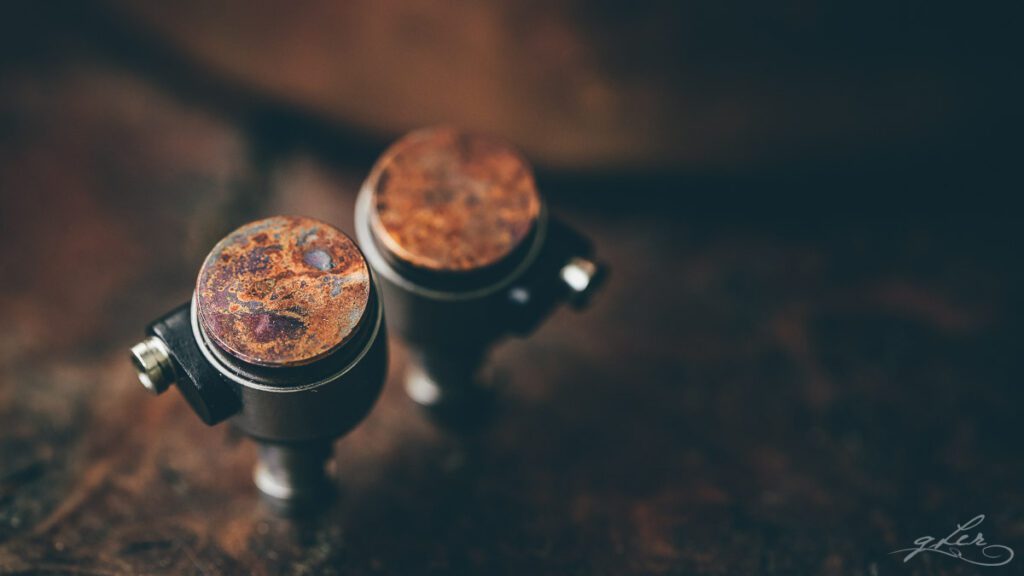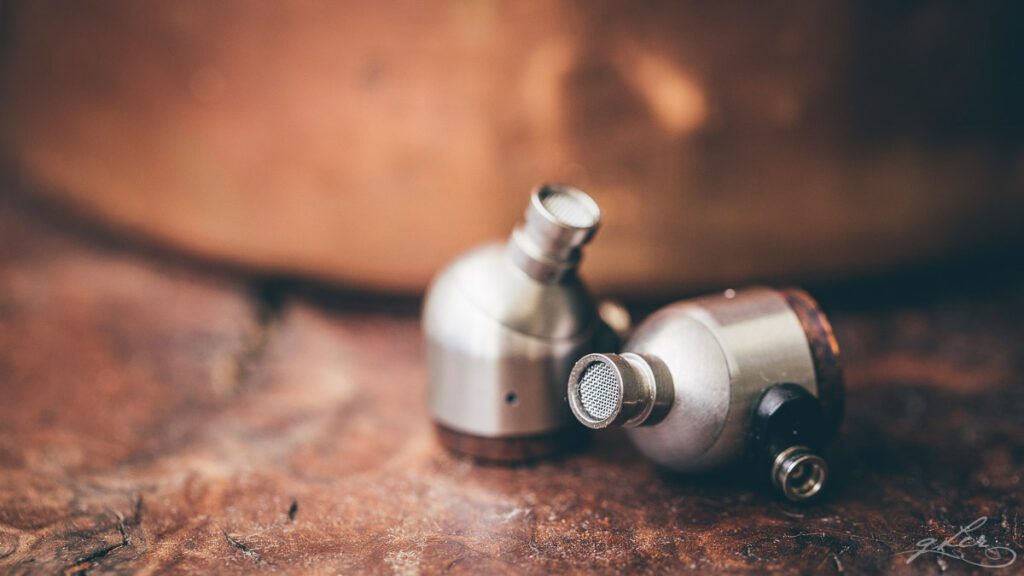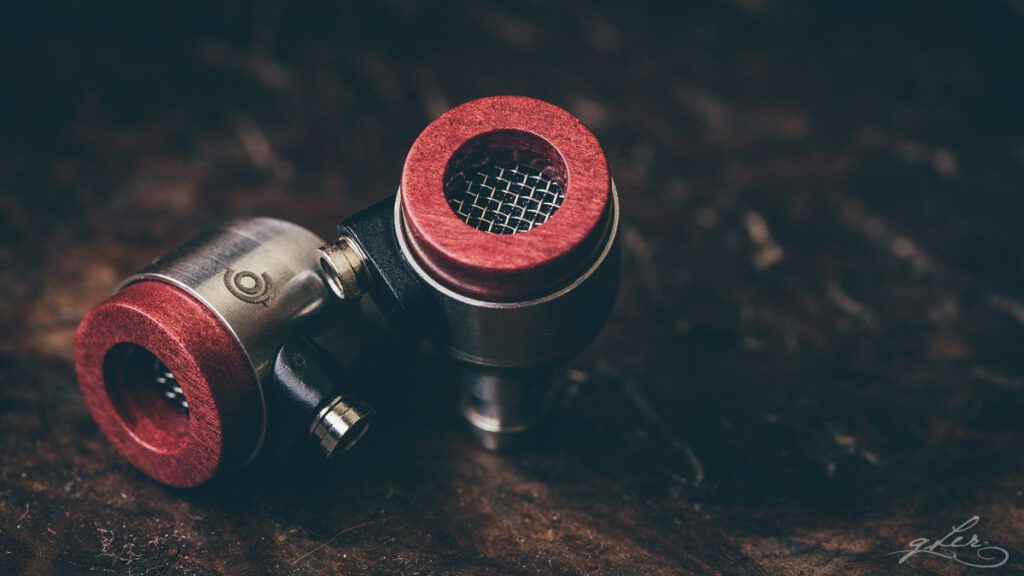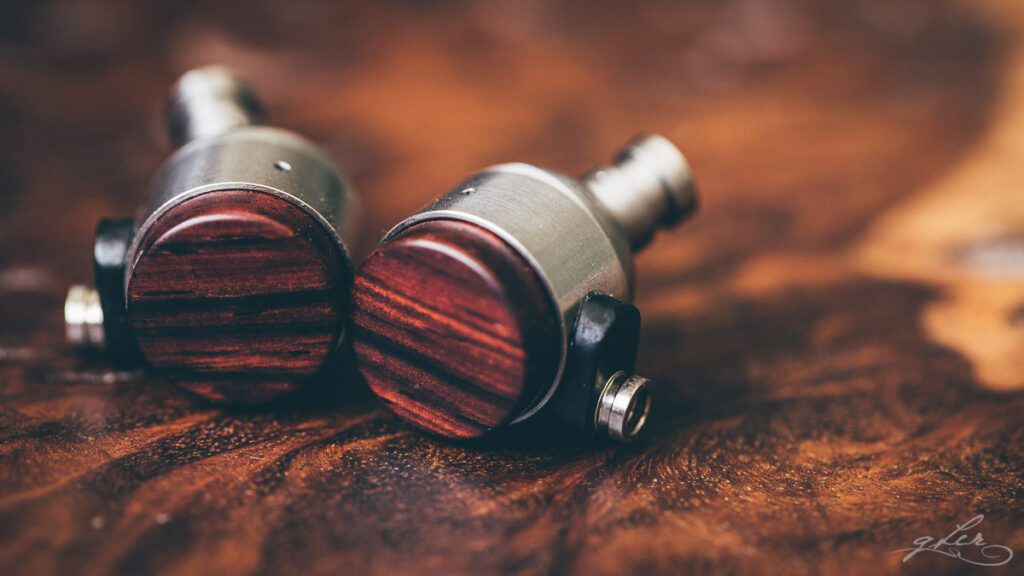Design and fit
This is where, for me, 634ears LOAK transcends your run-of-the-mill IEMs. These are meticulously handmade – but still precision-engineered – objects of beauty, with a distinctive steampunk look that you can’t help but admire from every angle.
In fact, if you’re interested in some of the thinking, theory and mechanics of what’s gone in to the design, from dynamic driver material choice, to an explanation of how sound is produced inside the shell, to how the different housing and backplate materials affect what you hear, head over to Musashi’s blog, where he covers these topics in detail (and also in English).
All three LOAKs I have with me are the T-variant: LOAK-T with Cocobolo, LOAK-TO (open) with Pink Ivory, and LOAK-TC (closed) with Copper. The T means the front of the housing is made from titanium. There’s an explanation on the blog as to why this is so, but the takeaway here is that titanium has the optimal weight-to-vibration reduction ratio of the different metals Musashi experimented with for the sound he was aiming for.

The back part of the housings is all made from stainless steel, and it’s the backplate that changes between models, tweaking the sound you ultimately hear.
One of the interesting insights from the blog, which I’ll share briefly here, is how and how much the different backplate materials affect the sound. An interesting tidbit I garnered from the blog is the space behind the dynamic driver (the rear part of the housing) doesn’t have a sound of its own.
The purpose of that space is to affect the way the dynamic driver moves, which in turn affects the sound you hear coming from the front of the driver, into the front part of the housing and through the nozzle. To that end, changing the backplate material affects the the characteristics of the rear cavity. For example, a solid copper backplate affects vibration absorption, which results from the air movement of the driver’s surface, differently to how a wooden backplate or an open backplate would.
Thus, this difference in flow and mechanics is the difference you hear – not, and this is important, the type of material used.
Remember, the space behind the driver doesn’t have a sound of its own, so you’re not hearing wooden overtones or brassy highlights when those materials are used in the backplate. Instead, all you’re hearing is how much or how little the material changes the air movement, that affects driver movement, that affects the sound.

While this might steal from the romanticism of the idea that you’re hearing a warmer sound because of the ‘warmer’ wood on your IEM backplate, that’s not really how it works (as you’ll soon read in the sound impressions). Musashi estimates the type of wood has a 10% to 30% impact on the type of sound you’ll hear from the IEM, and likewise different metals will have their own effect too, as would leaving the backplate open in the case of the LOAK-T (Open).
The backplate is unquestionably the star of the show, visually anyway, even though it’s a relatively small part of the overall design. The use of rare, natural woods and specially-coloured metals adds a certain lustre, refinement and personalization to each set of IEMs, since no two are ever going to look identical.
LOAK-T backplates are available in a wide range of exotic woods, from cocobolo to rosewood, ironwood, pink ivory and zebrawood, to name a few. There are also three variations of the LOAK-T with metal backplates: brass, copper and stainless steel. I have a distinctly red, coloured copper backplate version; that’s right, this is not a naturally-iodised copper, but rather one that’s been hand-coloured and cured using a 400-year-old technique by the artisans at Orii.

The shape of the IEMs themselves is also quite different to conventional designs. Each earpiece is made up of a bulbous two-part body (the front and rear sections), with the driver sandwiched somewhere in the middle. A short, stocky angled nozzle protrudes from the front section, while the backplate is made up of a solid piece of wood, metal, or open grille with a ring of wood or metal.
Each earpiece has a small protruding notch where the single MMCX connector attaches to a cable, along with a single vent for the dynamic driver. I mentioned earlier that the earpieces are designed to be worn either hanging down or over-ear, though I find over ear far more logical and comfortable, especially since the earpieces themselves have some weight to them. If you have massive ears/ear-canals you might struggle slightly with the shorter nozzle, but I had no issues getting a comfortable fit once I figured out which earpiece was left and right (hint: the right earpiece has an engraved 634ears logo on the shell).
I’d rate the overall design as excellent, the craftsmanship exceptional, and the comfort very good. Once properly seated, with the right tips and cable, the weight and odd proportions of the earpieces disappear, and I can listen unfussed for hours on end. It might take some tweaking for you to get there, but once you do, getting on with listening should be easy enough. Speaking of which, that comes next.

Continue to sound impressions…




One Response
Brilliant review, Guy. A very beautiful and detailed insight to the LOAK family of 634EARS, and frankly it has made me wonder should I go for an Open model next, as I refrained from getting one in fear of having the bass losing its physicality and outside noise interference.